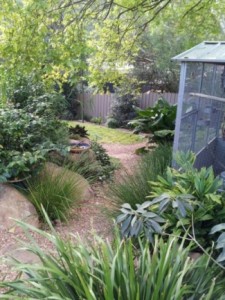By Mark Thomas
Gardening under trees can be difficult due to factors such as shade, root competition, reduced moisture, reduced nutrients and in the case of some trees allelopathy. Allelopathy is an ability some trees such as Eucalypts possess whereby chemicals secreted from the root system blocks growth and germination of other plants.
It is tempting to give up or plant the whole garden to Agapanthus as many gardeners in the Eucalyptus dominated areas of the hills currently do. An alternative is to use plants that naturally grow under trees that can cope with all the limitations while still looking great and attracting wildlife to your garden.
One of the most versatile groups of plants for this situation is the Correas, with many colours, sizes and forms available thriving in dappled light and semi- shade as well as coastal conditions. Where height is needed for screening or structure Correa alba var.alba is reliable in any well drained soil including clay that has had gypsum treatment. The bell shaped flowers are a magnet for nectar feeding birds and the dark green leaves have a contrasting light undersides.
Lower and with lots of bright colour are Correa “Jezabell” and Correa “Catie Bec” for highlighting garden edges and rockeries with pink bell flowers. There are even a few groundcover forms such as Correa pulchella “Autumn Blaze” with bright orange flowers found originally growing on Kangaroo Island.
Goodenia thrive in understorey conditions, most with masses of bright yellow flowers and fantastic for cottage style gardens as well. With many different species and forms available there are choices of large shrubs down to groundcovers. One species that would have grown on the Adelaide plains but still grows in some areas of the hills and coastal areas is Goodenia amplexans. With large leaves and fast growth this plant is very attractive, great cover for rockeries and likes being pruned which keeps the plant growing tightly.
Doryanthes are large lilies from Eastern Australia with leaves of mature specimens reaching 2-3m and masses of flowers on tall stalks. Both species are best suited to large spaces and are happy growing at the base of tree trunks. These plants are bold statements with strong architectural form.
Lomandra are generally smaller members of the lily family and most species are right at home with dappled light. They are ideal for edging and borders or just creating foliage contrast, especially if you have used a lot of shrubs in your design. Lomandra confertifolia “Little Pal” has a soothing and graceful lime green foliage that is soft to the touch. Lomandra multiflora ssp. dura is a local species little known or used in horticulture but with great potential. It has stiff silver –blue foliage with contrasting yellow flowers and the ability to cope with long periods of drought when established. Butterflies love the flowers and the foliage is host to the rare Phigalia Skipper butterfly while the seed is food for skinks.
Using plants that suit your conditions will always produce better results than trying to change your garden to grow plants that are incompatible. There are usually a large number of native plants that could suit any garden situation while saving water, providing food for wildlife and unique beauty.



